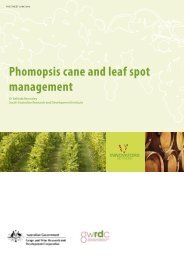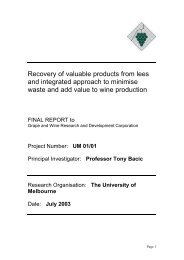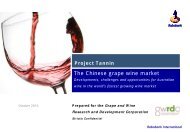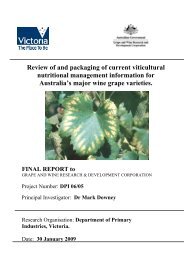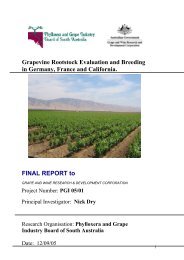Identification of the major drivers of 'phenolic' taste in ... - GWRDC
Identification of the major drivers of 'phenolic' taste in ... - GWRDC
Identification of the major drivers of 'phenolic' taste in ... - GWRDC
You also want an ePaper? Increase the reach of your titles
YUMPU automatically turns print PDFs into web optimized ePapers that Google loves.
AWRI: <strong>Identification</strong> Of The Major Drivers Of ‘Phenolic’ Taste In White W<strong>in</strong>es<br />
Organic acids have been shown to be astr<strong>in</strong>gent <strong>in</strong> <strong>the</strong>ir own right (Rubico and McDaniel 1992,<br />
Hartwig and McDaniel 1995). The astr<strong>in</strong>gency <strong>of</strong> equi-normal b<strong>in</strong>ary mixtures <strong>of</strong> organic acids<br />
<strong>in</strong>creased as pH decreased, but rema<strong>in</strong>ed unchanged when <strong>the</strong> normality <strong>of</strong> equi-pH solutions was<br />
<strong>in</strong>creased. This result suggests that pH ra<strong>the</strong>r than titratable acidity <strong>in</strong>fluences perceived astr<strong>in</strong>gency<br />
(Lawless et al. 1996). Fur<strong>the</strong>rmore, <strong>the</strong> astr<strong>in</strong>gency <strong>of</strong> organic acids has been shown to be <strong>in</strong>dependent<br />
<strong>of</strong> anion species aga<strong>in</strong> highlight<strong>in</strong>g <strong>the</strong> <strong>in</strong>fluence <strong>of</strong> pH. The <strong>in</strong>creased astr<strong>in</strong>gency <strong>of</strong> phenolics <strong>in</strong><br />
lower pH w<strong>in</strong>es may be due to direct changes <strong>in</strong> salivary rheology (Nordbo et al. 1984) or through<br />
enhanc<strong>in</strong>g <strong>in</strong>teractions between lubricat<strong>in</strong>g salivary prote<strong>in</strong>s and phenolics (Obreque-Slier et al. 2011).<br />
Glycerol is an important compound <strong>in</strong> white w<strong>in</strong>e, be<strong>in</strong>g <strong>the</strong> third most abundant after water and<br />
ethanol (Gawel et al. 2007). It is equi-sweet to glucose but despite its physical viscosity when <strong>in</strong> a<br />
pure form, it does not <strong>in</strong>crease <strong>the</strong> perceptual viscosity <strong>of</strong> dry table w<strong>in</strong>e (Noble and Bursick 1984;<br />
Gawel and Waters, 2008). However, due to <strong>the</strong>ir sweetness, both glycerol and residual sugar may play<br />
a role <strong>in</strong> moderat<strong>in</strong>g astr<strong>in</strong>gency (Lyman and Green 1990, Smith et al. 1996).<br />
1.4 W<strong>in</strong>emak<strong>in</strong>g<br />
Prior to fermentation, juice for white w<strong>in</strong>e production is typically expressed and separated from grapes<br />
by a sequence <strong>of</strong> unit processes <strong>in</strong>clud<strong>in</strong>g destemm<strong>in</strong>g, crush<strong>in</strong>g, dra<strong>in</strong><strong>in</strong>g and press<strong>in</strong>g. The f<strong>in</strong>al<br />
phenolic composition <strong>of</strong> a w<strong>in</strong>e depends not only on grape composition but also on <strong>the</strong> conditions that<br />
<strong>in</strong>fluenced <strong>the</strong>ir extraction <strong>in</strong>to <strong>the</strong> must, and on subsequent f<strong>in</strong><strong>in</strong>g, and pre and post bottle ag<strong>in</strong>g.<br />
The compartmentalisation <strong>of</strong> particular phenolics <strong>in</strong> different parts <strong>of</strong> <strong>the</strong> grape bunch present<br />
w<strong>in</strong>emakers with <strong>the</strong> ability to tailor <strong>the</strong> phenolic pr<strong>of</strong>ile <strong>of</strong> <strong>the</strong>ir juices with <strong>the</strong> view to creat<strong>in</strong>g w<strong>in</strong>es<br />
<strong>of</strong> a specific style. Free run juice is largely comprised <strong>of</strong> <strong>the</strong> hydroxyc<strong>in</strong>namates from <strong>the</strong> pulp,<br />
whereas press<strong>in</strong>gs conta<strong>in</strong> more flavonoids because <strong>of</strong> <strong>the</strong>ir greater abundance and consequent<br />
extraction from seeds and sk<strong>in</strong>s (Patel et al. 2010). They also showed that press<strong>in</strong>gs conta<strong>in</strong> less<br />
glutathione and caftaric acid, but more GRP than free run juice. This change <strong>in</strong> phenolic pr<strong>of</strong>ile<br />
follow<strong>in</strong>g press<strong>in</strong>g can be attributed to oxygen uptake dur<strong>in</strong>g <strong>the</strong> press cycle.<br />
Extraction <strong>of</strong> flavonoids is <strong>in</strong>creased by longer sk<strong>in</strong> contact times at higher temperatures and <strong>the</strong><br />
length and pressure applied dur<strong>in</strong>g <strong>the</strong> press cycle. The effect on <strong>in</strong>dividual phenolic compounds <strong>in</strong><br />
white w<strong>in</strong>es with different pre-fermentation maceration conditions, <strong>in</strong>clud<strong>in</strong>g contact time (2 to 24<br />
hours) and temperature (5, 10 or 20ºC), has been studied both on both an experimental and <strong>in</strong>dustrial-<br />
scale (Gomez-Miguez et al. 2007; Hernanz et al. 2007). These studies showed that <strong>in</strong>dividual<br />
compounds and classes <strong>of</strong> phenolics vary widely <strong>in</strong> <strong>the</strong>ir extraction dynamics and response to both<br />
temperature and time.<br />
Press<strong>in</strong>gs also have higher pH values result<strong>in</strong>g from greater extraction <strong>of</strong> potassium, and slightly lower<br />
titratable acidities and slightly higher total soluble solids than do free-run juices (S<strong>in</strong>gleton et al.<br />
1975).<br />
Once <strong>the</strong> grapes are pressed, <strong>the</strong>re are many chemical reactions that can occur, with enzymatic and<br />
non-enzymatic oxidation result<strong>in</strong>g <strong>in</strong> <strong>major</strong> changes to phenolics. Hyperoxidation is a technique<br />
practiced on must prior to <strong>the</strong> start <strong>of</strong> fermentation. It <strong>in</strong>volves saturat<strong>in</strong>g an unsulfited must with<br />
Page | 17




